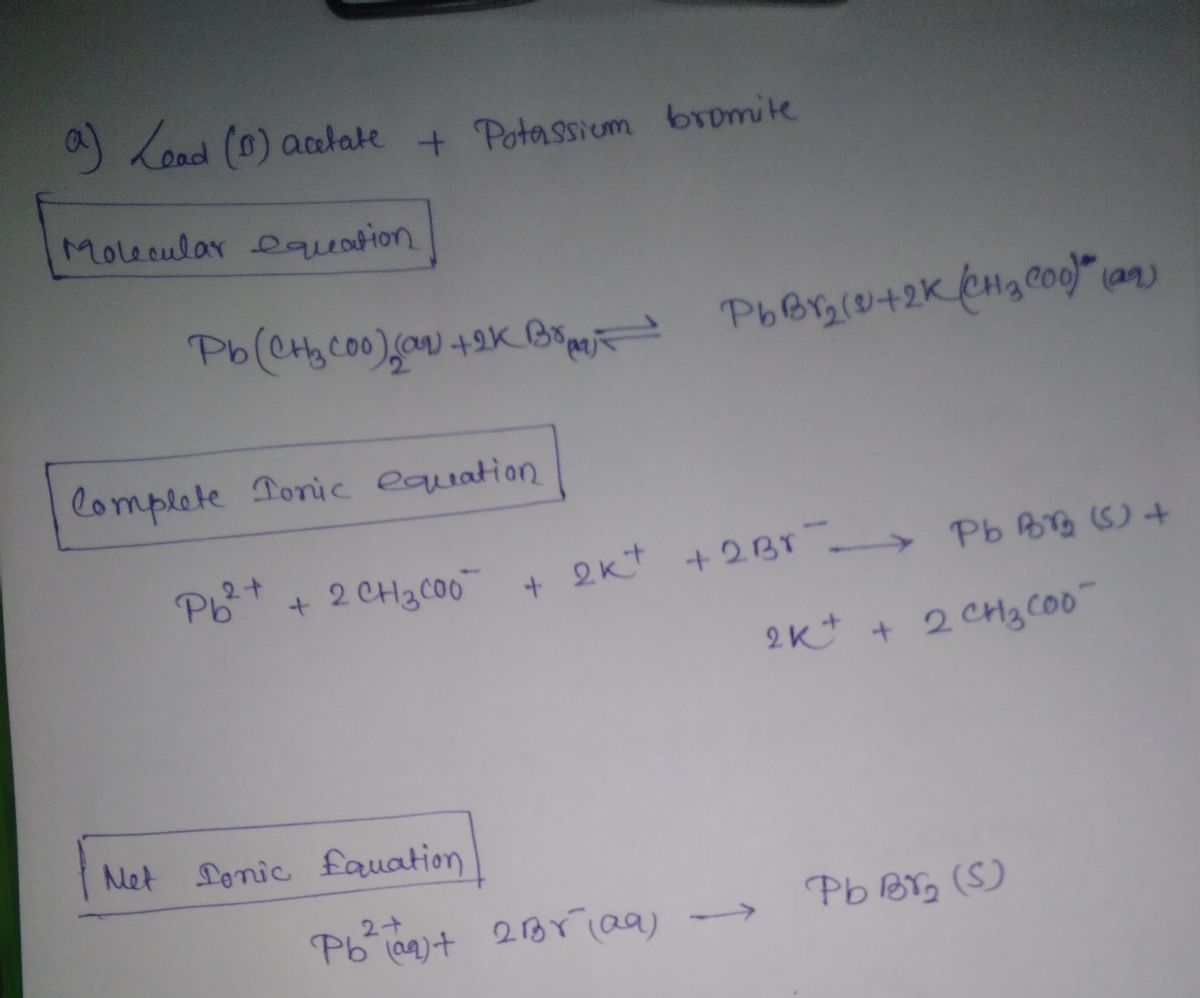Write out balanced molecular, complete ionic and net ionic equations for the following. Use physical state symbols, spaces where appropriate, and the equal sign instead of a reaction arrow. If a charge appea subscript, use parenthesis to separate them. For the complete ionic equations, write cation first, anion second and keep the order of the reactants the same as depic problem. For the net ionic equations, write cation first and anion second. Example: 3 Ag+(aq) + (PO4)3-(aq) = Ag3PO4(s) a) Lead(II) acetate + potassium bromite Molecular Equation Complete lonic Equation Net lonic Equation b) Nickel(III) nitrate + sodium carbonate Molecular Equation Complete lonic Equation Net lonic Equation
Write out balanced molecular, complete ionic and net ionic equations for the following. Use physical state symbols, spaces where appropriate, and the equal sign instead of a reaction arrow. If a charge appea subscript, use parenthesis to separate them. For the complete ionic equations, write cation first, anion second and keep the order of the reactants the same as depic problem. For the net ionic equations, write cation first and anion second. Example: 3 Ag+(aq) + (PO4)3-(aq) = Ag3PO4(s) a) Lead(II) acetate + potassium bromite Molecular Equation Complete lonic Equation Net lonic Equation b) Nickel(III) nitrate + sodium carbonate Molecular Equation Complete lonic Equation Net lonic Equation
Chemistry
10th Edition
ISBN:9781305957404
Author:Steven S. Zumdahl, Susan A. Zumdahl, Donald J. DeCoste
Publisher:Steven S. Zumdahl, Susan A. Zumdahl, Donald J. DeCoste
Chapter1: Chemical Foundations
Section: Chapter Questions
Problem 1RQ: Define and explain the differences between the following terms. a. law and theory b. theory and...
Related questions
Question
![# Educational Website Transcript: Writing Ionic Equations
**Topic: Writing Balanced Molecular, Complete Ionic, and Net Ionic Equations**
## Instructions
- Write balanced molecular, complete ionic, and net ionic equations for the following reactions.
- Use physical state symbols, spaces where appropriate, and an equal sign instead of a reaction arrow. If a charge appears after a subscript, use parentheses to separate them.
### Guidelines
1. **Complete Ionic Equations**
- Write cation first, anion second, keeping the order of reactants as depicted in the problem.
2. **Net Ionic Equations**
- Write cation first and anion second.
### Example
- **Chemical Equation**: 3 Ag+(aq) + (PO4)3-(aq) = Ag3PO4(s)
### Problems
#### a) Lead(II) acetate + potassium bromide
- **Molecular Equation**
- [Insert Answer]
- **Complete Ionic Equation**
- [Insert Answer]
- **Net Ionic Equation**
- [Insert Answer]
#### b) Nickel(II) nitrate + sodium carbonate
- **Molecular Equation**
- [Insert Answer]
- **Complete Ionic Equation**
- [Insert Answer]
- **Net Ionic Equation**
- [Insert Answer]
Use the spaces provided to fill in the equations on your own, ensuring you follow the guidelines for writing ionic equations accurately.](/v2/_next/image?url=https%3A%2F%2Fcontent.bartleby.com%2Fqna-images%2Fquestion%2F6bca0f7c-4a69-4d44-a0fc-404c8d0c241c%2F6d894235-a73e-4255-a1b9-8bec1ad22719%2Fvcdw38d_processed.jpeg&w=3840&q=75)
Transcribed Image Text:# Educational Website Transcript: Writing Ionic Equations
**Topic: Writing Balanced Molecular, Complete Ionic, and Net Ionic Equations**
## Instructions
- Write balanced molecular, complete ionic, and net ionic equations for the following reactions.
- Use physical state symbols, spaces where appropriate, and an equal sign instead of a reaction arrow. If a charge appears after a subscript, use parentheses to separate them.
### Guidelines
1. **Complete Ionic Equations**
- Write cation first, anion second, keeping the order of reactants as depicted in the problem.
2. **Net Ionic Equations**
- Write cation first and anion second.
### Example
- **Chemical Equation**: 3 Ag+(aq) + (PO4)3-(aq) = Ag3PO4(s)
### Problems
#### a) Lead(II) acetate + potassium bromide
- **Molecular Equation**
- [Insert Answer]
- **Complete Ionic Equation**
- [Insert Answer]
- **Net Ionic Equation**
- [Insert Answer]
#### b) Nickel(II) nitrate + sodium carbonate
- **Molecular Equation**
- [Insert Answer]
- **Complete Ionic Equation**
- [Insert Answer]
- **Net Ionic Equation**
- [Insert Answer]
Use the spaces provided to fill in the equations on your own, ensuring you follow the guidelines for writing ionic equations accurately.
Expert Solution
Step 1

Step by step
Solved in 2 steps with 2 images

Knowledge Booster
Learn more about
Need a deep-dive on the concept behind this application? Look no further. Learn more about this topic, chemistry and related others by exploring similar questions and additional content below.Recommended textbooks for you

Chemistry
Chemistry
ISBN:
9781305957404
Author:
Steven S. Zumdahl, Susan A. Zumdahl, Donald J. DeCoste
Publisher:
Cengage Learning

Chemistry
Chemistry
ISBN:
9781259911156
Author:
Raymond Chang Dr., Jason Overby Professor
Publisher:
McGraw-Hill Education

Principles of Instrumental Analysis
Chemistry
ISBN:
9781305577213
Author:
Douglas A. Skoog, F. James Holler, Stanley R. Crouch
Publisher:
Cengage Learning

Chemistry
Chemistry
ISBN:
9781305957404
Author:
Steven S. Zumdahl, Susan A. Zumdahl, Donald J. DeCoste
Publisher:
Cengage Learning

Chemistry
Chemistry
ISBN:
9781259911156
Author:
Raymond Chang Dr., Jason Overby Professor
Publisher:
McGraw-Hill Education

Principles of Instrumental Analysis
Chemistry
ISBN:
9781305577213
Author:
Douglas A. Skoog, F. James Holler, Stanley R. Crouch
Publisher:
Cengage Learning

Organic Chemistry
Chemistry
ISBN:
9780078021558
Author:
Janice Gorzynski Smith Dr.
Publisher:
McGraw-Hill Education

Chemistry: Principles and Reactions
Chemistry
ISBN:
9781305079373
Author:
William L. Masterton, Cecile N. Hurley
Publisher:
Cengage Learning

Elementary Principles of Chemical Processes, Bind…
Chemistry
ISBN:
9781118431221
Author:
Richard M. Felder, Ronald W. Rousseau, Lisa G. Bullard
Publisher:
WILEY